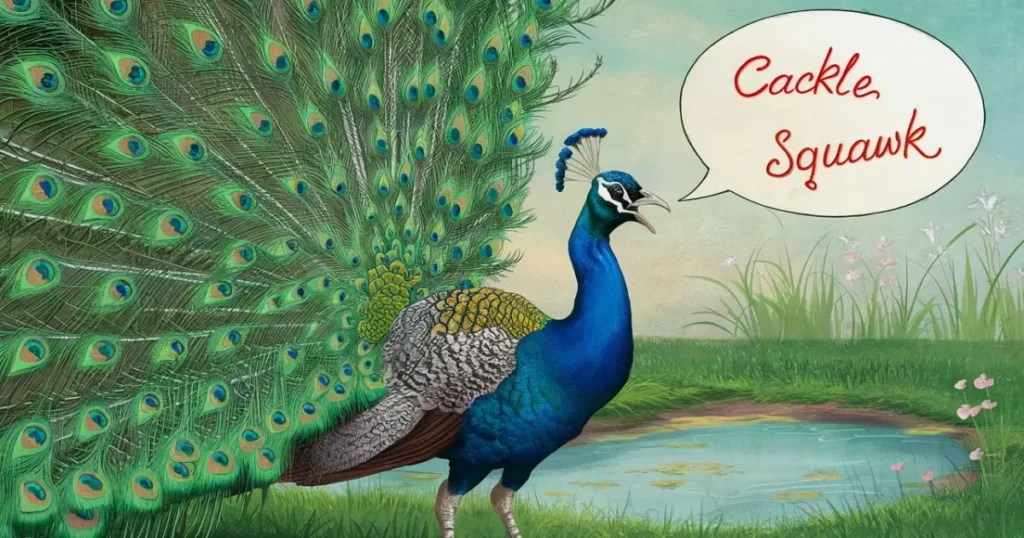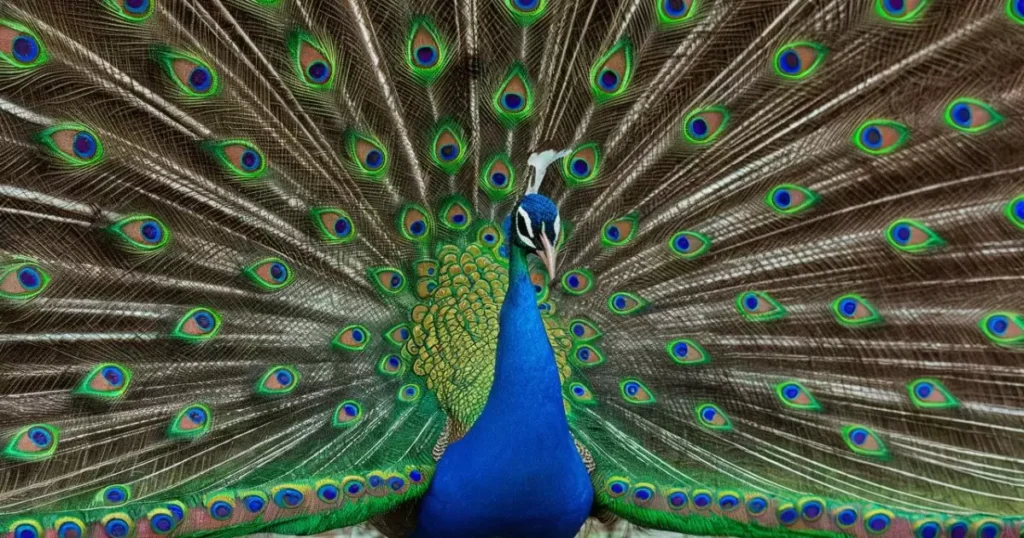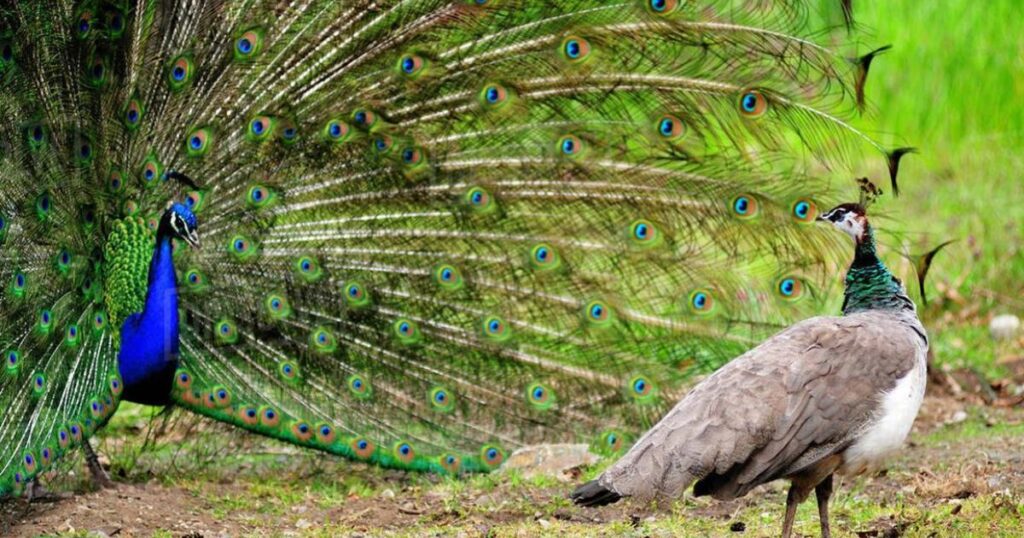Peacock are renowned for their breathtaking visual display, but their auditory expressions are equally captivating. These majestic birds punctuate the air with a diverse repertoire of vocalizations, contributing to nature’s symphony.
From the distinctive meow call to the urgent kraa alarm, each sound holds a unique purpose in the peacock’s world. In this comprehensive guide, we’ll unravel the science behind peacock calls, explore their meanings, and delve into the cultural and historical significance these avian voices hold.
What sounds do peacocks make?

Peacocks produce a range of noises for various purposes, ranging from alarm calls to courtship displays.
The following are some of the most typical noises made by peacocks:
Peacock scream: Peacocks are most known for their loud, high-pitched scream. During the mating season, when male peacocks are attempting to entice females, this is usually heard. Many people have said that the scream has the same sound as a wailing infant or a woman.
Peacock honk: During the mating season, peacocks also emit this sound. This loud, guttural call is meant to entice females and ward off intruding males.
Peacock rattle: Male peacocks shake their tail feathers quickly to produce a low, vibrating sound known as the rattle. This noise is a component of.
Peacock caw: When angry or startled, peacocks will emit this brief, loud sound. It sounds like what ravens produce.
Peahen call: To communicate with other females, the female peafowl, commonly known as the peahen, emits a range of noises, including a short succession of nasal notes.
Read More : 6 Common Cat Sleeping Positions When Sick: Your Key To Detecting Health Issues!
The Science of Peacock Calls
To understand peacock calls, we must first examine their anatomy. Peacocks are equipped with a remarkable vocal organ called the syrinx, located at the base of their trachea.
Unlike human vocal cords, the syrinx can produce two independent tones simultaneously, allowing for a diverse range of vocalizations.
Peacocks use their calls for various reasons, including:
- Attracting Mates: During mating season, males emit loud, prolonged calls to assert their presence and fitness to potential mates.
- Establishing Territory: Calls are used to stake a claim on a particular area, warning rivals to keep their distance.
- Signaling Danger: Urgent alarm calls alert others to potential threats, prompting them to take defensive measures.
The characteristics of these calls, such as pitch, volume, and duration, vary depending on their purpose, ensuring effective communication within the peacock community.
Types of Calls and Their Meanings

Peacocks have a rich vocabulary of sounds, each conveying a specific message. Let’s explore two of the most common calls:
- The Meow Call: Similar to a cat’s meow but louder and more resonant, this call is primarily used during mating season. It’s a signal of the male’s fitness, designed to attract females’ attention. When making this call, males often engage in an elaborate visual display, fanning their iridescent tails and shaking their feathers to create a rustling sound, adding an auditory component to their spectacle.
- The Kraa Call: This loud, harsh sound serves as an alarm or distress signal, warning others of potential danger. When uttering this call, peacocks exhibit tense body language, with their feathers tightly packed and their movements erratic, indicating their readiness to flee or confront the threat.
Peacock Calls in Comparison to Other Birds
While peacock calls share similarities with other avian species, they also possess unique qualities. The kraa call, for instance, is not exclusive to peacocks; it’s found in crows and other birds, though with a harsher tone.
This similarity illustrates the evolutionary parallels among species, where different birds develop similar solutions to common problems, such as warding off predators.
The meow call doesn’t have a direct counterpart in other bird species, underscoring the peacock’s distinct place in the avian world.
Comparisons of Calls Between Different Species of Peacocks
While the Indian Peafowl is the most common species, there are others, like the Green Peafowl and Congo Peafowl, each with its unique set of calls. For example:
- Green Peafowl: These birds have a louder, more resonant call that echoes through their forest habitats, adapted to their environment.
- Congo Peafowl: Their calls are lower-pitch, almost growl-like, a sound adapt to their denser jungle environment.
These variations highlight the adaptations each species has undergone to suit their specific environments, showcasing nature’s versatility.
The Role of Peacock Calls in Human Culture and History

Peacock calls have reverberated throughout human history, finding their place in various cultural and religious contexts:
- Hindu Mythology: In Hindu beliefs, the peacock’s call is a symbol of the monsoon’s arrival, bringing life-giving rain.
- Greek and Roman Mythology: The peacock is associate with Hera (Juno), the queen of the gods, and its call was believe to herald her presence.
- European Folklore: In some traditions, a peacock’s cry is seen as a bad omen, while in others, it’s considered a rain-bringer.
In modern times, recorded peacock calls serve as calming nature sounds in various therapeutic and meditation practices, highlighting the continued significance of these majestic birds in human life.
Conclusion
Peacock calls are a testament to nature’s ingenuity. From the multifaceted meow to the urgent kraa, these sounds are an integral part of the peacock’s survival and social strategies.
They’re not just nature sounds; they’re a language, conveying messages that, while not always decipherable to us, are clear and meaningful within the avian community. So, the next time you hear a peacock call, listen closely. It’s not just a sound; it’s a story.
FAQs
What does it mean when a peacock honks?
A peacock’s honk is likely the kraa call, signalling distress or danger. This harsh sound is accompanied by tense body language and erratic movements, indicating the bird is ready to flee or confront a potential threat.
What does it mean when a peacock makes a clicking sound?
Peacocks don’t necessarily make a clicking sound, but they may create a rustling noise by shaking their feathers. This sound often accompanies their meow calls and visual displays during mating season, adding an auditory component to their courtship rituals.
What sound does a peacock make in words?
The main sounds peacocks make are describe as meow and kraa due to their similarities to those words. The meow call is used during mating season to attract mates, while the kraa call serves as an alarm or distress signal.







